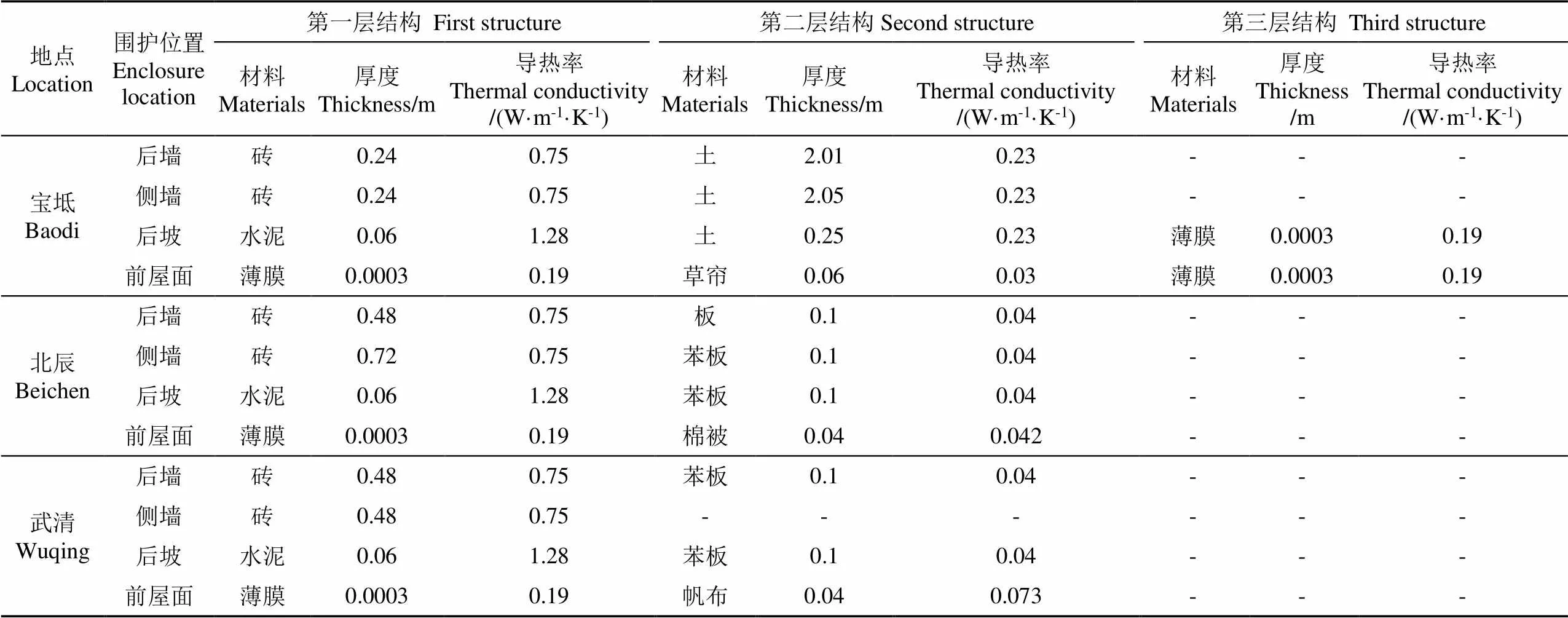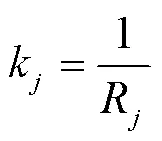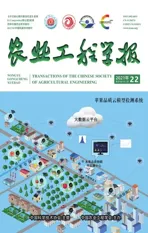基于夜间室内外温差计算方法的日光温室气候分类
2021-02-19黎贞发董朝阳薛庆禹刘淑梅
黎贞发,刘 涛,董朝阳,薛庆禹,刘淑梅
基于夜间室内外温差计算方法的日光温室气候分类
黎贞发,刘 涛,董朝阳,薛庆禹,刘淑梅
(天津市气候中心,天津 300074)
为了解决日光温室园艺作物越冬栽培茬口合理安排问题,同时减少低温灾害风险,开展温室保温性评价并进行科学分类。该研究选取天津市3种典型日光温室设置室内外小气候观测试验,结合不同温室构型及建筑材料,基于热传导原理形成日光温室夜间室内外温差计算方法,并以此为基础评价不同类型温室保温能力,进而对天津地区主要日光温室类型进行划分,提出不同类别温室适宜种植蔬菜建议。结果表明:1)温室保温常数能较好地反映日光温室保温性能差异,3种典型日光温室保温常数分别为20.34、15.84、13.21。2)温差计算方法可以较好模拟不同类型日光温室室内气温变化,温差模拟值与实测值决定系数(R)在0.70以上,均方根误差RMSE范围为1.97%~3.86%。3)利用1960—2020年气候观测资料按气候保证率80%计算其最低气温、最小湿度及最小风速值,模拟得到当地不同保温能力日光温室的极端最低温度值为3~14 ℃,按照果蔬生长发育指标需求,提出日光温室分类标准,可分为耐寒叶菜型、叶菜适宜型、果叶混合型、果菜适宜型及喜温果菜型,并在2016—2020年温室改造与评估实际应用中得到验证。该研究可为解决中国日光温室类型多且构型复杂,难以量化评价其保温性能及合理安排种植茬口的难题提供方案参考。
温度;日光温室;传热系数;温室构型;保温常数;分类
0 引 言
据农业农村部农业机械化管理司发布的统计数据,2018年中国温室面积达196.37 hm²,是2008年的2.4倍,栽培面积和产量稳步上升[1]。特别是2020年,《农业农村部关于加快推进设施种植机械化发展的意见》明确指出:到2025年,以塑料大棚、日光温室和连栋温室为主的种植设施总面积稳定在200万hm²以上。日光温室作为设施栽培的一种,其以后墙及山墙为保温蓄能围护墙体,以太阳能为主要能源进行越冬生产,采用单屋面塑料薄膜,特别适合中国三北地区开展越冬蔬菜种植,近年来发展迅速,近40%的设施蔬菜是由日光温室提供[2],日光温室能否安全高效种植对于反季节蔬菜供应十分重要。然而,日光温室基于用途、结构形式、覆盖材料等方面的不同,有不同命名方式,同一类温室基于不同角度、按不同方法可以划分为多种类型[3-6]。实践表明,通过以往温室分类方式进行生产安排和规模化标准化种植,容易导致温室果蔬茬口搭配不合理、作物品种选择不科学、灾害风险高等问题[7-8],也是导致近年温室效益下降的主要因素。因此,探索一种更科学合理且普适性强的日光温室分类方法具有较强的迫切性和实际生产意义,也是目前一个重要的技术难点和研究热点。
当前,各地多以温室维护结构和材料来划分类型,分类方式多种多样。按照覆盖材料可分为玻璃温室、PC板温室和薄膜温室等,按照温室构型可分为单体温室(单拱棚温室、单坡面温室、双坡面温室等)和连栋温室,按照温室主体结构材料可分为金属结构温室和非金属结构温室等[9-11]。而在设施农业生产中,又将目前生产应用上的日光温室划分为“普通日光温室”“第一代节能型日光温室”“第二代节能型日光温室”和“第三代节能型日光温室”[12]。李清明等[13]指出山东地区日光温室随着跨度、高度增加,结构材料改良以及内部设备优化,命名分类方式采用“代”来进行标注,如“第二代日光温室”“第三代日光温室”,“五代”之后根据不同地区温室改进特点改用年代进行标注和分类。可以看出,上述分类命名方式虽然可以直观表明相关日光温室构型、材料及当前优化水平,但也很难实现日光温室的合理分类,主要表现在:同一构型温室因生产地域不同,温室所能提供作物的生长环境各不相同;同一地域因温室建设类型不同或结构相同而保温材料差异,其温室内的小气候环境也存在较大差异;在生产上难以开展规模化作物种植与管理。另外,通过总结单一类型温室的技术成果难以推广至其他构型温室或其他地域,限制了技术方法的通用性。因此,基于温室内气候资源水平进行日光温室分类对于设施农业生产及建立普适性温室内环境预报模型具有重要指导意义,同时对提高温室生产管理水平、合理温室空间布局也极为必要[14-16]。另一方面,当前国内外相关专家针对温室内环境气候模拟研究较多,其中,国外专家主要基于物质交换和能力平衡角度进行研究[17-20],国内专家则主要基于数据统计[21]、流体力学[22-23]、主成分分析[24]、神经网络[25-28]、随机森林算法[29]等方法来模拟预测温室内环境。但以这些方法为基础再进一步进行日光温室气候分类则存在很大困难,相关研究未见报道。
本研究以日光温室室内外热交换原理为基础,综合温室各部分建筑材料的热力学参数、构型以及几何特征,根据温室维持室内外温室温差的能力以及温室所在地的冬季气候资源状况进行温差分类,提出更为科学合理且普适性强的分类方法,为日光温室设计和合理利用提供科学依据。
1 材料与方法
试验于2011—2014年冬季(11月—翌年3月)在天津市北部设施农业聚集区的3种典型日光温室内进行,方法推广应用分别于2016—2018年冬季在天津蓟州区侯家营恒丰蔬菜合作社种植基地和2019—2020年冬季在天津市武清区聚鸿庄园及清泰庄园2个园区内进行。试验地点位于华北平原,多年平均气温12.3℃,年均日照时数2 527 h,年平均降水量564 mm,主要集中在6—10月。
1.1 试验材料及设计
小气候观测试验分别在天津市农业科学院武清基地(116.96°E,39.43°N,海拔6.95 m)、北辰双街镇(117.14°E,39.29°N,海拔5.16 m)、宝坻圣人庄(117.28°E,39.74°N,海拔9.12 m)内的3个典型二代日光温室内进行。温室具体建筑结构见图1,主要包括前屋面、后墙、后坡和侧墙四个围护结构,涉及温室脊高、跨度、后墙高、后坡投影和前屋面构型等主要参数。日光温室围护结构的组成及材料导热率见表1,其中前屋面的主要建筑材料是塑料薄膜,夜间会覆盖其他保温材料,常见的有棉被、草帘、牛津布和帆布;后墙、侧墙和后坡主要建筑材料为土、砖或苯板。


图1 天津市典型日光温室横截面示意图

表1 天津市典型日光温室建筑材料
在3种典型温室内部与外部分别放置气象要素监测设备,室内观测仪器为中环天仪(天津)气象仪器有限公司生产的DZN1型农田小气候观测仪(气温测量范围:-40~50 ℃,精度0.1 ℃;空气湿度测量范围:5%~100%,精度1%;总辐射测量范围:0~1 400 W/m2,精度5 W/m2),观测要素为室内空气温度和空气湿度。室外观测仪器为中环天仪(天津)气象仪器有限公司生产的DZZ6型自动气象站(气温测量范围:-50~50 ℃,精度0.1 ℃;空气湿度测量范围:5%~100%,精度1%;风速测量范围:0~60 m/s,精度0.1 m/s),观测要素为室外空气温度、风速及空气湿度。日光温室内外监测设备数据采集频率设定为10 min一次。
1.2 计算方法
1.2.1 室内外温差计算方法
日光温室是中国北方地区主要的蔬菜栽培设施。在越冬季节尤其是低温天气,日光温室所能达到的内外温差以及能保持的最低温度是评价其保温性能好坏的重要指标。对于无辐射增温的夜间低温,温室的保温性能与其建筑结构的综合传热能力和种植区域的气候条件密切相关。本研究给出了日光温室夜间室内外温差模型,温差由公式(1)计算而得
式中∆为日光温室夜间室内外温差,℃;为日光温室室外气温,℃;为日光温室室外风速,m/s;RH为日光温室室外相对湿度,%;c为温室保温常数;T为温度系数;W为风速系数;RH为湿度系数。其中,温室保温常数c为温室室外气温为0、风速为0、空气干洁(不含有水汽的纯净空气)情况下温室所能维持的室内外温差值。
1.2.2 综合传热系数计算
综合传热系数决定于日光温室围护结构的传热性,由各层围护的结构传热系数按照权重进行累加得到。综合传热系数越高,日光温室的保温性能越差。日光温室围护结构包括后墙、后坡、侧墙、前坡(包括前坡透明覆盖材料及保温被等),每个围护结构由一层或多层材料构成。具体计算公式如下[30]



式中为日光温室综合传热系数;为日光温室某一围护结构的传热系数,W/m2·℃;为日光温室某一围护结构占综合传热系数的权重,为某一围护结构的传热阻,℃/W;R、R、R分别为内表面换热阻、该围护结构热阻和外表面换热阻,℃/W;为单层结构热阻,℃/W;为材料层厚度,m;为材料导热系数,W/m2·℃;为日光温室某一围护结构占综合传热系数的权重;为日光温室暴露在空气中的总表面积,m2;为日光温室某一围护结构暴露在空气中的表面积,m2。
1.2.3 温差模型相关常数及系数模拟
保温常数、温度系数、风速系数及湿度系数与综合传热系数密切相关,通过Matlab拟合50种常用拟合关系方程,分析对比得到最优相关方程如下所示

式中表示要素系数,包括温度系数(T)、风速系数(W)及湿度系数(RH);、、为待定参数,利用实际观测数据及公式(1)曲线拟合获得。
1.2.4 数学模型评价方法
选择国际通用的指标和方法对日光温室夜间室内外温差计算方法准确性进行评价。首先对实际观测值及模拟值通过趋势线进行拟合,比较模拟值与实测值之间的吻合程度,同时选用统计指标对模型模拟能力进行定量的评价。本文选择决定系数R及均方根误差 RMSE进行实测值和模拟值拟合程度比较。
式中O为实际观察值,S为数学模型模拟值,为样本数。各评价指标说明:均方根误差(RMSE)用于计算模拟值及实测值之间的偏差,越小说明模型模拟误差越小。决定系数(R)用于衡量模拟值及实测值去实现的拟合程度,越接近1,说明模型模拟与实际值得吻合度越高。
2 结果与分析
2.1 日光温室夜间室内外温差模型的关键参数确定
根据天津市3种典型日光温室的温室构型数据资料,由公式(2)~(7)可得不同类型日光温室综合传热系数(表2),结果表明3种类型日光温室中,宝坻综合传热系数最低,其次为北辰,武清最高,说明宝坻保温性能最高,其次为北辰,武清较差。基于求得的综合传热系数,通过公式(8)~(9)拟合2013—2014年室内外气候数据,计算不同温室保温常数、温度系数、湿度系数及风速系数的相关要素系数,结果如表3所示,进而得到不同温室保温常数、温度系数、湿度系数及风速系数。

表2 不同类型日光温室温差模型参数表

表3 不同类型日光温室温差模型要素系数表
2.2 日光温室夜间室内外温差模型方法验证
通过2013—2014 年夜间温室内外实测温度求算模型关键参数后,利用2011—2012年夜间温室内外实测温差及模拟温差对模型主要参数进行验证评估,模拟验证结果如图2所示。由图2可知:3种温室类型的室内外温差模拟值与实测值的决定系数R均在0.70以上,RMSE分别为2.083、3.857和1.968 ℃。可以看出,日光温室室内外温差模型可以较好模拟不同类型日光温室室内外温差变化,可以作为一种计算夜间日光温室室内外温差的有效方法。
2.3 基于温差模型计算天津典型日光温室最低温
为了更好体现本方法在日光温室保温性能评估及种植茬口合理规划的应用价值,本文以武清温室为例,通过设定温室达到不同保温常数时,计算气候保证率为80%(生产上认为保证率达到80%风险较为可控)条件下,温室所能出现的最低气温。气候保证率是表示气候因子在某一界限值以上或以下出现的累积概率,用来表征某等级气候因子保证出现的可能性的统计量。以气候保证率为80%的最低温度为界限,可以保证绝大多数年份下温室正常生产,因此以该指标作为指导作物规模化标准化栽培的科学依据。本文利用1961—2020年共60 a天津武清站气候数据资料,计算得到气候保证率为80%条件下的最低气温、最低湿度及最小风速分别为-11.4 ℃、48.0%及5.6 m/s。同时根据天津市不同品种越冬蔬菜种植对日光温室保温要求,分别计算保温常数为22、19、17、15、13、10的温室(按照天津典型日光温室保温要求,以16为基准,上下分别增减1、2、3得到)在指定气候背景条件下所能维持的室内外温差,根据室外最低气温获得温室内最低气温值,结果如表4所示。在指定外部条件下,保温常数10、13、15、17、19和22的日光温室室内维持温差水平分别在14.4、17.1、19.0、21.0、22.9和25.8 ℃,最低气温分别为3.0、5.7、7.6、9.6、11.5和14.4 ℃。
2.4 基于保温能力的天津典型日光温室类型分类与应用
通常日光温室越冬期间所能维持的极端最低温度值是决定其能否安全种植不同蔬菜类型的主要指标,因此,本文以室内最低温度为界限指标对天津地区温室进行分类。基于越冬期间温室维持内外温差能力对天津市典型日光温室进行分类,同时充分考虑温室分布区域种植特点和温室围护结构,最终以其适宜种植的蔬菜类型进行命名并提供种植结构建议,具体分类结果如表5所示。其中,耐寒叶菜型:温室保温常数介于10~13,温室在最冷月可保证最低气温高于3~6 ℃,此类温室多为砖围护结构,因前坡面占整个温室围护表面积比例高,散热降温快,可用于生产耐寒叶菜;叶菜适宜型:温室保温常数介于13~15,温室在最冷月可保证最低气温高于6~8 ℃,此类温室多为砖围护结构,因前坡面占整个温室围护表面积比例较高,保温性能受到一定影响,可用于生产一般叶菜;果叶混合型:温室保温常数介于15~19,温室在最冷月可保证最低气温高于8~11 ℃,冬季生产月(12月至2月)高于10 ℃有效积温大于596~960 ℃·d,此类温室有两种,一种是砖围护结构,前坡面占整个温室围护表面积比例适中,保温性能优于一般砖围护结构,可用于生产叶菜及部分耐寒果菜,但风险较高易受冻害影响;另一种温室多为土围护结构,跨度较大,温室前坡面散热较大,因此保温性略差,可用于西红柿等对温度需求不高的果菜生产,进行喜温果菜种植时风险较高;果菜适宜型:温室保温常数介于19~22之间,温室在最冷月可保证最低气温高于11~14 ℃,冬季生产月高于10 ℃有效积温大于960~1 233 ℃·d,可用于一般果菜生产,如黄瓜、西红柿等;喜温果菜型:温室保温常数高于22,温室在最冷月可保证最低气温高于14 ℃,冬季生产月高于10 ℃有效积温大于1 233 ℃·d,利于对温度要求较高的果菜进行生产。

表4 指定气候背景下不同保温常数日光温室内外温差维持能力

表5 基于温差方程进行天津市日光温室分类
基于上述计算公式和分类方法,在2016—2020年期间对天津市蓟州恒丰蔬菜基地、武清聚鸿庄园和武清清泰庄园3个种植茄子、辣椒等茄果类蔬菜的设施园区开展日光温室保温性能评估应用。通过对3个园区温室结构、建筑材料以及室外历史气象资料的收集整理,建立室内外温差计算模型,得到温室保温常数及相关系数,完成温室类别划分。结果表明:3个园区日光温室保温常数为11.52~11.89,温差值为15.3~16.8 ℃,偏冷年份温室内最低气温为-1.3~2.1 ℃,正常年份温室内最低气温3.5~4.2 ℃,偏暖年份温室内为5.5~8.9 ℃,3个园区的日光温室均属于耐寒叶菜型温室,在偏冷和正常年份种植喜温茄果类蔬菜极易发生冷害和冻害,建议进行棚室结构改造、保温材料替换,或改种叶菜。
3 讨 论
本研究提出的日光温室分类方法充分考虑了温室所处气候条件、建筑结构、建筑材料以及覆盖材料,相较于单纯以材料或构型作为分类依据的方法更具科学依据,同时也解决了以“代”、“型”、“改良”等关键词作为类型标注的不规范做法[31-36]。此外,关键的温差参数计算只用到常规气候观测资料和温室基础参数,可在有长期气候观测地区进行推广应用,进而解决对不同地区、不同年代、不同结构以及不同材料日光温室保温性能评价与比较的问题,同时可以最大程度避免以往研究中因为缺乏试验或数据样本过少造成的模拟不准确[37-38]。
考虑到日光温室实际生产立地条件及能量传导过程复杂,本研究结果还存在一定不足和拓展方向。主要包括:1)研究时段为冬季(12月至次年2月),温室分类依据是基于其所能维持的最低温,没有考虑低温持续时间及低温寡照、暴雪、强风等特殊天气的影响;2)研究是在气候保证率为80%条件下对日光温室进行气候分类,未考虑20%的极端气候条件所造成的灾害影响,后续需针对极端气候条件下日光温室所能维持的温度水平和灾害风险开展进一步研究;3)模拟计算结果是在温室未采取加温状态下取得的,考虑到目前温室普遍配备辅助加温设施,下一步将针对有辅助加温措施的温室进行保温性能评估研究;4)日光温室内外温差除主要受建筑材料及覆盖材料热传导影响外还受温室密闭性、温室蓄热能力及室内环境条件等方面影响[39-41],下一步将尝试采用计算流体力学(CFD)等方法对温室内气流场和温度场等非稳态过程进行模拟,来考虑冷风渗透等因素的影响,完善和提高温室保温性的模拟方法和精度,提高温室气候分类的精确度。
4 结 论
本研究探索基于气象观测和热传导机理评价日光温室保温能力,提出了一种具有普适性的日光温室分类新方法。
1)基于热传导机理新研发了一种日光温室夜间室内外温差计算方法用以评价日光温室保温能力,且方法通过了不同温室不同年份验证(模拟值与实测值决定系数2均在0.70以上,均方根误差RMSE范围为1.968~3.857 ℃。
2)基于保温能力进行日光温室气候分类,天津地区日光温室可以划分为耐寒叶菜型、叶菜适宜性、果叶混合型、果菜适宜型及喜温果菜型日光温室。分类方法既考虑了温室维护结构、材料等影响保温性能的主要因素,同时也考虑了分类地区的长期气候资源状况,最终得到以保温能力为主要指标的定量化分类结果,对推动规模化标准化温室作物种植管理具有实用价值,在针对多种构型日光温室性能评估与分类方面进行了成功实践。
[1] 中华人民共和国农业农村部农业机械化管理司. 农业机械化情况专刊2020年第1期[N/OL]. 2020-01-06[2021-08-10]. http://www.njhs.moa.gov.cn/nyjxhqk/202001/P020200106362040875833.
[2] 程陈,董朝阳,黎贞发,等. 日光温室芹菜外观形态及干物质积累分配模拟模型[J]. 农业工程学报,2021,37(10):142-151.
Cheng Chen, Dong Chaoyang, Li Zhenfa, et al. Simulation model of external morphology and dry matter accumulation and distribution of celery in solar greenhouse[J]. Transactions of the Chinese Society of Agricultural Engineering (Transactions of the CSAE), 2021, 37(10): 142-151. (in Chinese with English abstract)
[3] 陈青云. 日光温室的实践与理论[J]. 上海交通大学学报:农业科学版,2008,26(5):343-350.
Chen Qingyun. Progress of practice and theory in sunlightgreenhouse[J]. Journal of Shanghai Jiaotong University: Agricultural Science, 2008, 26(5): 343-350. (in Chinese with English abstract)
[4] 秦琳琳,陆林箭,石春,等. 基于物联网的温室智能监控系统设计[J]. 农业机械学报,2015,46(3):261-267.
Qin Linlin, Lu Linjian, Shi Chun, et al. Implementation of IOT-based greenhouse intelligent monitoring system[J]. Transactions of the Chinese Society for Agricultural Machinery, 2015, 46(3): 261-267. (in Chinese with English abstract)
[5] 赵喆,李兴,王健,等. 新型连栋日光能温室小气候初探[J]. 西北农林科技大学学报:自然科学版,2020,48(5):88-98.
Zhao Zhe, Li Xing, Wang Jian, et al. Preliminary study on microclimate of new multi-span solar energy greenhouse[J]. Journal of Northwest A&F University: Natural Science Edition, 2020, 48(5): 88-98. (in Chinese with English abstract)
[6] 王孝卿,李楠,薛晓萍. 寿光日光温室小气候变化规律及模拟方法[J]. 中国农学通报,2012,28(10):236-242.
Wang Xiaoqing, Li Nan, Xue Xiaoping. The microdimate change rules and simulation method of greenhouse in Shouguang city[J]. Chinese Agricultural Science Bulletin, 2012, 28(10): 236-242. (in Chinese with English abstract)
[7] 魏瑞江,孙忠富. 我国日光温室小气候研究进展与展望[J]. 西北农林科技大学学报,2014,42(12):139-150.
Wei Ruijiang, Sun Zhongfu. Development and perspective of research on microclimate of sunlight greenhouse in China[J]. Journal oI Northwest A&F University, 2014, 42(12): 139-150. (in Chinese with English abstract)
[8] 黎贞发,王铁,刘德义,等. 日光温室气象监测与灾害预警系统研制[J]. 气象科技,2011,39(2):247-252.
Li Zhenfa, Wang Tie, Liu Deyi, et al. Greenhouse weather monitoring and disaster warning system development[J]. Meterological Science and Technology, 2011, 39(2): 247-252. (in Chinese with English abstract)
[9] 李宗耕,李宝石,刘文科. 北京地区日光温室室内外环境要素特征分析[J]. 农业工程,2019,9(6):59-62.
Li Zonggeng, Li Baoshi, Liu Wenke. Feature analysis of indoor and outdoor environmental factors of solar greenhouse in Beijing[J]. Agricultural Engineering, 2019, 9(6): 59-62. (in Chinese with English abstract)
[10] 张继波,薛晓萍,李楠,等. 持续寡照对温室番茄开花座果,产量及果实品质的影响[J]. 气象与环境学报,2020,36(2):85-91.
Zhang Jibao, Xue Xiaoping, Li Nan, et al. Effects of continuous shading stress on flower-fruit, yield and fruit quality of greenhouse tomato[J]. Journal of Meteorology and Environment, 2020, 36(2): 85-91. (in Chinese with English abstract)
[11] 徐超,王明田,杨再强,等. 高温对温室草莓光合生理特性的影响及胁迫等级构建[J]. 应用生态学报,2021,32(1):231-240.
Xu Chao, Wang Mingtian, Yang Zaiqiang, et al. Effects of high temperature on photosynthetic physiological characteristics of strawberry seedlings in greenhouse and construction of stress level[J]. Chinese Journal of Applied Ecology, 2021, 32(1): 231-240. (in Chinese with English abstract)
[12] 李天来. 我国日光温室产业发展现状与前景[J]. 沈阳农业大学学报,2005,36(2):131-138.
Li Tianlai. Current situation and prospects of greenhouse industry development in China[J]. Journal of Shenyang Agricultural University, 2005, 36(2): 131-138. (in Chinese with English abstract)
[13] 李清明,魏珉,张大龙. 山东省日光温室结构类型[J]. 农业工程技术,2018,38(19):26-32.
Li Qingming, Wei Min, Zhang Dalong. Structure types of sunlight greenhouse in Shandong[J]. Agricultural Engineering Technology, 2018, 38(19): 26-32. (in Chinese with English abstract)
[14] 毛罕平,晋春,陈勇. 温室环境控制方法研究进展分析与展望[J]. 农业机械学报,2018,49(2):1-13.
Mao Hanping, Jin Chun, Chen Yong. Research progress and prospect on control methods of greenhouse environment[J]. Transactions of the Chinese Society for Agricultural Machinery, 2018, 49(2): 1-13. (in Chinese with English abstract)
[15] 赵丽玲,颉建明,赵贵宾. 不同日光温室结构类型温光特性研究[J]. 西南农业学报,2015,28(4):1803-1808.
Zhao Liling, Xie Jianming, Zhao Guibin. Study structure and characteristics of temperature and light in different solar greenhouse[J]. Southwest China Journal of Agricultural Sciences, 2015, 28(4): 1803-1808. (in Chinese with English abstract)
[16] 陈正法,梁称福,黄小平. 四湖地区节能日光温室结构和原理[J]. 农业工程学报,2000,16(1):75-78.
Chen Zhengfa, Liang Chengfu, Huang Xiaoping. Structure and principle of energy-saving solar greenhouse in Sihu area of Hubei province[J]. Transactions of the Chinese Society of Agricultural Engineering (Transactions of the CSAE), 2000, 16(1): 75-78. (in Chinese with English abstract)
[17] Nebbali R, Roy J C, Boulard T. Dynamic simulation of the distributed radiative and convective climate within a cropped greenhouse[J]. Renewable Energy, 2012, 43: 111-129.
[18] Seginer I, Boulard T, Bailey B J. Neural network models of the greenhouse climate[J]. J Agric Eng Res, 1994, 59(3): 203-216.
[19] Patil S L, Tantau H J, Salokhe V M. Modelling of tropical greenhouse temperature by auto regressive and neural network models[J]. Biosystems Eng, 2008, 99(3): 423-431.
[20] Ferreira P M, Faria E A, Ruano A E. Neural network models in greenhouse air temperature prediction[J]. Neurocomputing, 2002, 43(1): 51-75.
[21] 柳芳,王铁,刘淑梅. 天津市二代节能型日光温室内部温湿度预测模型:以西青为例[J]. 中国农业气象,2009,30(增刊1):86-89.
Liu Fang, Wang Tie, Liu Shumei. Research on temperature and humidity forecasting model for energy saving solar greenhouse in Tianjin: Taking Xiqing as an example[J]. Chinese Journal of Agrometeorology, 2009, 30(Suppl. 1): 86-89. (in Chinese with English abstract)
[22] 任守纲,杨薇,王浩云,等. 基于CFD的温室气温时空变化预测模型及通风调控措施[J]. 农业工程学报,2015,31(13):207-214.
Ren Shougang, Yang Wei, Wang Haoyun, et al. Prediction model on temporal and spatial variation of air temperature in greenhouse and ventilation control measures based on CFD[J]. Transactions of the Chinese Society of Agricultural Engineering (Transactions of the CSAE), 2015, 31(13): 207-214. (in Chinese with English abstract)
[23] 鲍恩财,邹志荣,张勇. 主动蓄热日光温室不同气流方向后墙传热CFD模拟[J]. 农业工程学报,2018,34(22):169-177.
Bao Encai, Zou Zhirong, Zhang Yong. CFD simulation of heat transfer in back-wall of active thermal-storage solar greenhouse with different airflow directions[J]. Transactions of the Chinese Society of Agricultural Engineering (Transactions of the CSAE), 2018, 34(22): 169-177. (in Chinese with English abstract)
[24] 李宁,申双和,黎贞发,等. 基于主成分回归的日光温室内低温预测模型[J]. 中国农业气象,2013,34(3):306-311.
Li Ning, Shen Shuanghe, Li Zhenfa, et al. Forecast model of minimum temperature inside greenhouse based on principal component regression[J]. Chinese Journal of Agrometeorology, 2013, 34(3): 306-311. (in Chinese with English abstract)
[25] 程曼,袁洪波,蔡振江,等. 基于全局变量预测模型的温室环境控制方法[J]. 农业工程学报,2013,29(25):177-183.
Cheng Man, Yuan Hongbo, Cai Zhenjiang, et al. Environment control method in greenhouse based on global variable prediction model[J]. Transactions of the Chinese Society of Agricultural Engineering (Transactions of the CSAE), 2013, 29(25): 177-183. (in Chinese with English abstract)
[26] 邹伟东,张百海,姚分喜,等. 基于改进型极限学习机的日光温室温湿度预测与验证[J]. 农业工程学报,2015,31(24):194-200.
Zou Weidong, Zhang Baihai, Yao Fenxi, et al. Verification and forecasting of temperature and humidity in solar greenhouse based on improved extreme learning machine algorithm[J]. Transactions of the Chinese Society of Agricultural Engineering (Transactions of the CSAE), 2015, 31(24): 194-200. (in Chinese with English abstract)
[27] 陈昕,唐湘璐,李想,等. 二次聚类与神经网络结合的日光温室温度二步预测方法[J]. 农业机械学报,2017,48(增刊):353-358.
Chen Xin, Tang Xianglu, Li Xiang, et al. Two-steps prediction method of temperature in solar greenhouse based on twice cluster analysis and neural network[J]. Transactions of the Chinese Society for Agricultural Machinery, 2017, 48(Suppl): 353-358. (in Chinese with English abstract)
[28] 郁莹珺,徐达宇,寿国忠,等. 基于经验模态分解和小波神经网络的温室温湿度预测[J]. 江苏农业科学,2019,47(1):211-216.
Yu Yingjun, Xu Dayu, Shou Guozhong, et al. Prediction of greenhouse temperature and humidity based on empirical mode decomposition and wavelet neural network[J]. Jiangsu Agricultural Sciences, 2019, 47(1): 211-216. (in Chinese with English abstract)
[29] 刘红,党晓东,都全胜,等. 基于随机森林算法的日光温室内气温预测模型研究[J]. 中国农学通报,2020,36(25):95-100.
Liu Hong, Dang Xiaodong, Du Quansheng, et al. Temperature prediction model in solar greenhouse based on stochastic forest algorithm[J]. Chinese Agricultural Science Bulletin, 2020, 36(25): 95-100. (in Chinese with English abstract)
[30] 薛庆禹,黎贞发,宫志宏,等. 一种日光温室夜间室内外温差的估算方法:CN106204306B [P]. 2019-06-25[2021-08-10].
[31] 刘淑梅,薛庆禹,李春,等. 天津地区不同墙体处理对日光温室保温性能影响初探[J]. 中国农学通报,2012,28(35):170-179.
Liu Shumei, Xue Qingyu, Li Chun, et al. Effects of different wall treatments on thermal insulation of solar greenhouse in Tianjin area[J]. Chinese Agricultural Science Bulletin, 2012, 28(35): 170-179. (in Chinese with English abstract)
[32] 张勇,许英杰,陈瑜,等. 新型相变材料蓄放热性能测试及在温室内的应用[J]. 农业工程学报,2021,37(7):218-226.
w Zhang Yong, Xu Yingjie, Chen Yu, et al. Heat storage and release performance of new phase change material and its application in greenhouse[J]. Transactions of the Chinese Society of Agricultural Engineering (Transactions of the CSAE), 2021, 37(7): 218-226. (in Chinese with English abstract)
[33] 鲍恩财,曹晏飞,邹志荣,等. 不同结构主动蓄热墙体日光温室传热特性[J]. 农业工程学报,2019,35(3):189-197.
Bao Encai, Cao Yanfei, Zou Zhirong, et al. Characteristic of heat transfer for active heat storage wall with different structures in Chinese solar greenhouse[J]. Transactions of the Chinese Society of Agricultural Engineering (Transactions of the CSAE), 2019, 35(3): 189-197. (in Chinese with English abstract)
[34] 钱旭同. 改善蔬菜温室结构性能的研究[J]. 中国农业科学,1963,4(2):36-44.
Qian Xutong. Study on improving the structure and performance of vegetable greenhouse[J]. Scientia Agricultura Sinica, 1963, 4(2): 36-44. (in Chinese with English abstract)
[35] 曹晏飞,荆海薇,赵淑梅,等. 日光温室后屋面投影宽度与墙体高度优化[J]. 农业工程学报,2017,33(7):183-189.
Cao Yanfei, Jing Haiwei, Zhao Shumei, et al. Optimization of back roof projection width and northern wall height in Chinese solar greenhouse[J]. Transactions of the Chinese Society of Agricultural Engineering (Transactions of the CSAE), 2017, 33(7): 183-189. (in Chinese with English abstract)
[36] 黎贞发,于红. 持续低温及低温连阴天气下几种典型日光温室保温性能评价环境因素模拟[J]. 中国农学通报,2013,29(23):123-128.
Li Zhenfa, Yu Hong. Analysis of insulation performance of several typical greenhouses under continuous low temperature and overcast weather[J]. Chinese Agricultural Science Bulletin, 2013, 29(23): 123-128. (in Chinese with English abstract)
[37] 王孝卿,李楠,薛晓萍. 寿光日光温室小气候变化规律及模拟方法[J]. 中国农学通报,2012,28(10):236-242.
Wang Xiaoqing, Li Nan, Xue Xiaoping. The microclimate change rules and simulation method of greenhouse in Shouguang city[J]. Chinese Agricultural Science Bulletin, 2012, 28(10): 236-242. (in Chinese with English abstract)
[38] 富建鲁,周长吉,王柳. 连栋玻璃温室采暖热负荷计算方法[J]. 农业工程学报,2020,36(21):235-242.
Fu Jianlu, Zhou Changji, Wang Liu. Methods for calculation of heating load in gutter-connected glasshouse[J]. Transactions of the Chinese Society of Agricultural Engineering (Transactions of the CSAE), 2020, 36(21): 235-242. (in Chinese with English abstract)
[39] 乔正卫,邹志荣,张立明,等. 4种日光温室保温被室内的试验性能测试[J]. 西北农林科技大学学报:自然科学版,2008,36(6):153-158.
Qiao Zhengwei, Zou Zhirong, Zhang Liming, et al. Laboratory test of four kinds of heat preservation quilts for solar greenhouse[J]. Journal of Northwest A&F University: Natural Science Edition, 2008, 36(6): 153-158. (in Chinese with English abstract)
[40] 鲍恩财,曹晏飞,邹志荣,等. 节能日光温室蓄热技术研究进展[J]. 农业工程学报,2018,34(6):1-14.
Bao Encai, Cao Yanfei, Zou Zhirong, et al. Research progress of thermal storage technology in energysaving solar greenhouse[J]. Transactions of the Chinese Society of Agricultural Engineering (Transactions of the CSAE), 2018, 34(6): 1-14. (in Chinese with English abstract)
[41] 张恩太,范涛,钱宝玲,等. 日光温室冬季环境因子变化关系研究[J]. 中国农学通报,2017,33(22):90-94.
Zhang Entai, Fan Tao, Qian Baoling, et al. Change relationship of environmental factors in sunlight greenhouse in winter[J]. Chinese Agricultural Science Bulletin, 2017, 33(22): 90-94. (in Chinese with English abstract)
Climate classification of solar greenhouse based on the calculation method for indoor and outdoor temperature difference at night
Li Zhenfa, Liu Tao, Dong Chaoyang, Xue Qingyu, Liu Shumei
(,300074,)
Various types of solar greenhouses with complex configurations have been widely used in China in recent years. Evaluating the thermal insulation performance of a solar greenhouse can greatly contribute to accurately arranging the cultivation stubble of horticultural crops in winter. The risk of low temperature can also be reduced, according to the optimal classification of solar greenhouses. In this study, a comprehensive model was proposed to clarify the relationship between vegetable planting and the climate types of the solar greenhouse using an indoor-outdoor temperature difference at night. An experiment was also conducted in the winter periods of 2011—2014 (from November to March of the following year) in the facility agricultural cluster in the northern Tianjin, located at North China Plain with an annual average temperature of 12.3 ℃, the average sunshine hours of 2 527 h, and the average precipitation of 564 mm. Three typical solar greenhouses were selected to observe the indoor and outdoor microclimate. A calculation model was also established using the indoor-outdoor temperature difference, according to the different structure configurations, building materials, and heat conduction in the solar greenhouse. The thermal insulation performance of solar greenhouses was evaluated to determine the climate classification. The results showed that: 1) The thermal insulation constant (c) was an excellent indicator to evaluate the thermal insulation performance of the solar greenhouses. The specific values were 20.34, 15.84, and 13.21 for the three typical solar greenhouses, respectively. 2) The calculation model well simulated the temperature changes in the solar greenhouses with the coefficient of determination (2) higher than 0.70, and the root mean square error (RMSE) 1.968-3.857 ℃, indicating an outstanding performance of the model. 3) The extremely minimum temperature was obtained ranging from 3 ℃ to 14.4 ℃ for the different types of solar greenhouses using the minimum temperature, humidity, and wind speed, according to the climate observation from 1960 to 2020 with the climate guarantee rate of 80%. According to the growth and development indicators of fruits and vegetables, a new classification standard was proposed for the solar greenhouses, including the cold-tolerant leafy vegetables, leafy vegetable suitability, fruit-leaf mixed type, fruit-vegetable suitable, and temperature-loving fruit-vegetable type. Moreover, this classification was verified in the actual application of greenhouse renovation and evaluation in the planting base of Hengfeng vegetable cooperative in Houjiaying, Jizhou City, Tianjin in the winter of 2016-2018, as well as in the two parks of Juhong and Qingtai manor, Wuqing City, Tianjin of China in the winter of 2019-2020. Hence, these findings and recommendations can provide strong support to guide the vegetable planting in the different types of solar greenhouses.
temperature; solar greenhouse; heat transfer coefficient; greenhouse configuration; insulation constant; classification
黎贞发,刘涛,董朝阳,等. 基于夜间室内外温差计算方法的日光温室气候分类[J]. 农业工程学报,2021,37(22):194-201.doi:10.11975/j.issn.1002-6819.2021.22.022 http://www.tcsae.org
Li Zhenfa, Liu Tao, Dong Chaoyang, et al. Climate classification of solar greenhouse based on the calculation method for indoor and outdoor temperature difference at night[J]. Transactions of the Chinese Society of Agricultural Engineering (Transactions of the CSAE), 2021, 37(22): 194-201. (in Chinese with English abstract) doi:10.11975/j.issn.1002-6819.2021.22.022 http://www.tcsae.org
2021-08-10
2021-11-03
天津市农业科技成果转化与推广项目(201502150);国家自然科学基金项目(31901398)
黎贞发,正研级高级工程师,研究方向为设施园艺环境监测与调控、都市农业气象服务技术。Email:lzfaaa@126.com
10.11975/j.issn.1002-6819.2021.22.022
S625.2
A
1002-6819(2021)-22-0194-08
